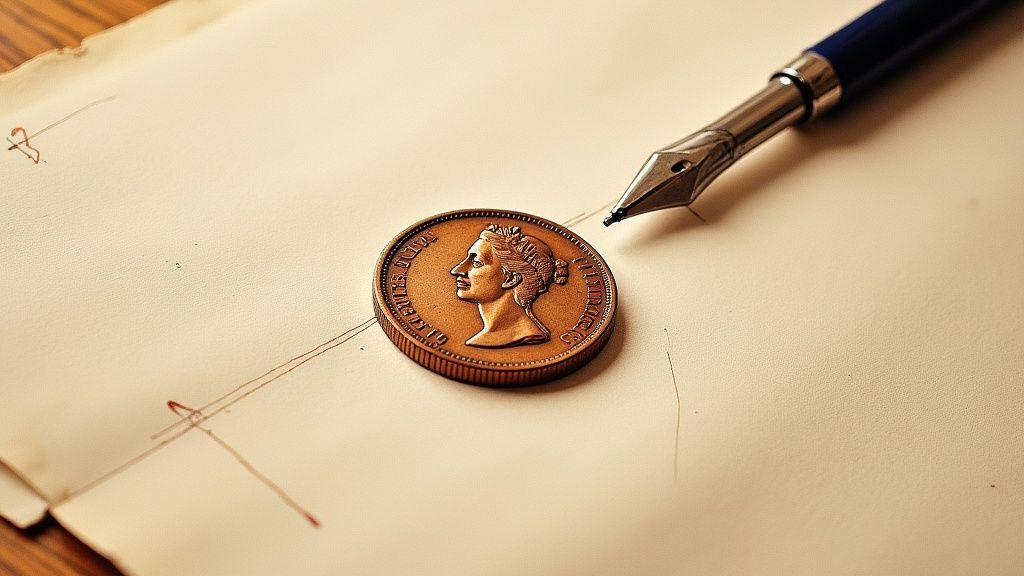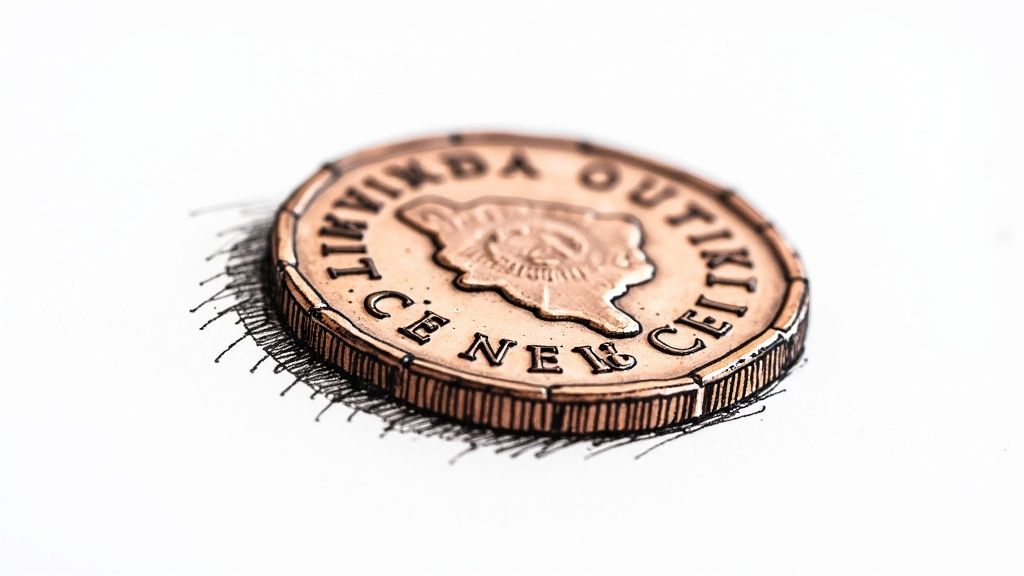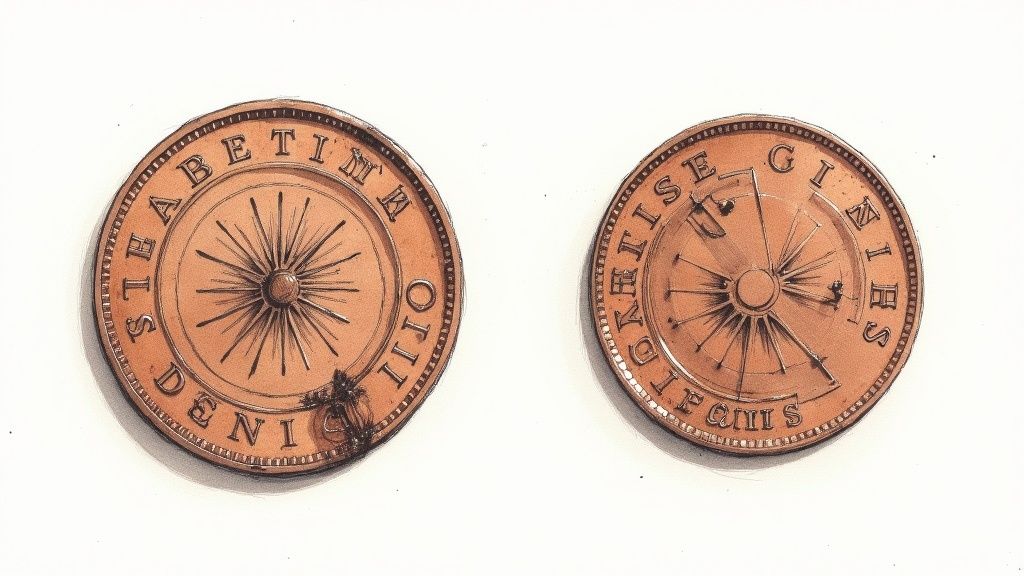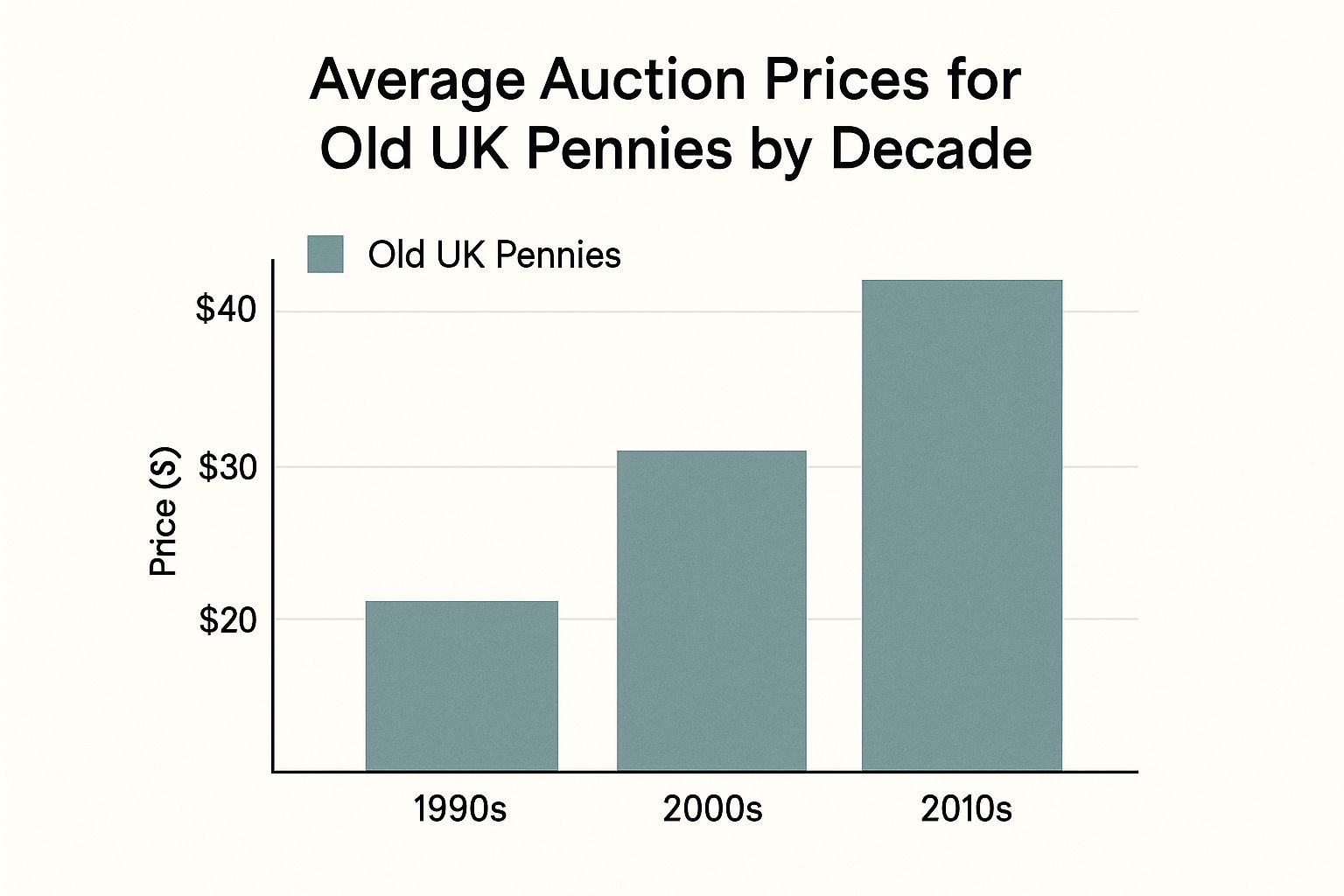Got a jar full of old copper pennies tucked away somewhere? Before you write them off as nothing more than obsolete shrapnel, you should know that some of those coins could be worth a lot more than you think. The real value of old UK pennies isn’t just about age; it’s a story told by four key things: its date, how many were made, its physical condition, and which monarch is on the front.
Unlocking the Value in Your Jar of Pennies

It helps to think of that jar less like loose change and more like a collection of tiny historical artefacts. Every single coin has a story, and for a collector, that story is exactly what creates value. A penny that seems completely ordinary can suddenly become a sought-after prize, sometimes fetching hundreds or even thousands of pounds, all depending on its unique details.
This guide is here to help you go from just having some old coins to being able to spot what makes them special. We’ll walk through the main factors that determine a penny's worth, showing you what separates a common coin from a rare treasure. Once you know what to look for, you can start sifting through your own collection to see if you have any hidden gems.
What Determines a Penny's Worth?
Figuring out the value of an old UK penny always comes down to four core pillars. A coin’s final market price is a blend of all these elements working together. Think of it like a puzzle – you need all the pieces in place to see the full picture.
Here are the primary factors you need to check:
- The Date: This is your first and most important clue. The year a penny was minted is directly tied to its mintage figure—that is, the total number of coins produced that year. A low mintage number is an immediate sign of potential scarcity.
- Mintage Rarity: It's not just about the date. Some pennies are rare for other reasons, like being minted for colonies, having errors from the minting process, or being part of a limited "proof" set made specifically for collectors.
- Physical Condition (Grade): A crisp, uncirculated coin will always be worth far more than a heavily worn one from the same year. The amount of detail left on the monarch’s portrait and the clarity of the lettering are absolutely critical.
- The Monarch: While age alone doesn’t guarantee value, coins from certain reigns are highly prized by collectors. Specific portraits, like Queen Victoria's famous 'Bun Head' design, are particularly sought-after and can add another layer of demand.
A penny isn’t just a piece of metal; it’s a snapshot of history. Its value is determined not by what it could buy then, but by the story its rarity and condition tell us now. Understanding this is the first step to becoming a successful collector.
The Story of the Pre-Decimal British Penny

To really get to grips with what makes an old UK penny valuable, you have to take a quick step back in time. Before the UK switched to the system we use today in 1971, money was a different beast altogether. This was the pre-decimal era, built on a beautifully complex system of pounds, shillings, and pence (£sd).
Just imagine this: one pound (£) was made up of 20 shillings, and each shilling was worth 12 pennies. That meant there were a whopping 240 pennies in a single pound. This isn't just a quirky bit of history; it’s fundamental. It dictated how these coins were used, how many were made, and ultimately, what they're worth to a collector today.
The Royal Mint didn't just churn out the same number of pennies each year. Production levels were a direct response to the nation's economy, major world events, and even which monarch was on the throne. Understanding this backstory is the first step to spotting a truly valuable coin.
Scarcity Forged by History
The journey of the old bronze penny is a fascinating one, with its roots deep in British history. As part of the traditional pounds-shillings-pence system, its production was a mirror to the times. Events like the world wars or economic slumps had a huge impact on how many pennies the Royal Mint struck each year. This is a critical piece of the puzzle for determining a coin's value, which you can read more about in the penny's history on Wikipedia).
It’s these ups and downs in production that create rarity. In certain years, the demand for new pennies was so low that none were produced for general circulation at all.
After World War II, for instance, the need for new pennies plummeted. This led the Mint to stop production entirely in 1949 and make a pretty drastic decision in the following decade.
By the end of the 1950s, the Royal Mint took the extraordinary step of melting down surplus pennies worth £1.2 million. This single act wiped millions of coins from existence, instantly creating scarcity and turning what was once common pocket change into a potential collector's prize.
From Common Coin to Collectable
This history really shines a light on two of the biggest drivers of a penny's value:
- Low Mintage Years: Years when only a small number of coins were made are naturally more valuable. Simple supply and demand.
- Artificially Created Scarcity: Events like the mass melting of surplus coins took a huge number out of the equation, making the survivors much harder to come by.
On top of this, some pennies minted during the 1950s weren't even meant for use in Britain. They were shipped out to British colonies, which means very few ever circulated on home soil. These are now incredibly scarce and highly prized by collectors.
The whole system changed on 15th February 1971, a day that became known as "Decimal Day." The new penny was now worth 1/100 of a pound, and the old era was over. The large, old pennies were officially taken out of circulation and stopped being legal tender after 31st August 1971. Their days of buying things were done, but for collectors, their story—and their value—was just getting started.
Identifying Key Dates and Mintage Rarity

The first thing you’ll want to check on an old penny is the date. Think of it as the coin's birth certificate, and it’s your best initial clue to figuring out its value. For collectors, it all boils down to a simple principle: the fewer coins made in a certain year, the more people want them today.
This production number is what we call the mintage figure, and it’s the foundation of a coin's rarity. If over 100 million pennies were struck in a single year, it's a safe bet that your coin is common. But if the mintage dipped below a million? Now you’ve got something interesting. It’s this dramatic swing in production that makes one penny worth pocket change and another a genuine find.
Locating the Date and Understanding Mintage
On most pre-decimal pennies, finding the date is straightforward. Just flip it over to the reverse (the "tails" side) and look below the seated figure of Britannia. Once you have the year, the real detective work begins: finding out its mintage. This is what separates a common keepsake from a potential treasure. For a deeper dive into all the factors that make a coin valuable, you can learn more about how to value old English coins in our collector's guide.
Just look at the difference a year can make:
- High Mintage Year: In 1967, the Royal Mint churned out a staggering 150 million pennies. They are incredibly common and, as a result, hold very little value beyond their history.
- Low Mintage Year: Compare that to the 1951 penny. Only 120,000 were ever minted, and most were shipped off for use in British colonies. Finding one in the UK is a real challenge, making it a highly prized coin.
Special Cases and Created Scarcity
While the date is your starting point, it isn't the whole story. Sometimes, rarity isn't about low production numbers but about unique circumstances that create a scarce coin out of the blue. These special cases can transform an otherwise ordinary penny into something collectors eagerly hunt for.
A coin's story is just as important as its statistics. Errors, limited editions, and coins intended for other countries all contribute to a narrative of scarcity that drives collector interest and, ultimately, value.
Keep an eye out for these unique situations:
- Proof Coins: These aren't your everyday pennies. Struck with specially polished dies for a stunning, mirror-like finish, they were made in tiny quantities for collectors and were never meant for circulation.
- Minting Errors: Even the Royal Mint makes mistakes. Coins struck off-centre, with the wrong metal, or with mismatched front and back designs (known as mule errors) are exceptionally rare and often very valuable.
- Colonial Issues: As we saw with the 1951 penny, some coins were minted specifically for use in British territories. Because they never circulated in the UK, they are much harder for British collectors to find.
Grading Your Penny's Condition
Picture this: you have two rare pennies, both minted in the same year. One looks like it’s been through the wars—scratched, worn, and dull. The other is so sharp and clear it could have just left the Royal Mint yesterday. Even though they share a date, their values will be poles apart. This is where “grading” comes in.
Grading is simply the method collectors use to describe a coin's physical condition. Think of it as a quality score. A penny that’s been passed from hand to hand for a century will show obvious scuffs, flattened details, and a general lack of crispness. In contrast, one that was squirreled away in a drawer will still have its original shine and all the intricate details of the design.
Getting your head around this is vital. In fact, a coin's condition often has a much bigger impact on the value of old UK pennies than its age or even how many were made. A common-date penny in pristine, uncirculated condition can easily fetch more than a genuinely rare penny that’s in poor, heavily worn shape.
Learning the Grading Scale
The world of coin collecting, or numismatics, uses a specific scale to define a coin's condition. While it can get quite detailed at the expert level, the basic grades are straightforward enough for anyone to learn.
When you're starting out, focus your attention on the clarity of the monarch's portrait—especially the hair and facial features. Also, check how legible the smaller details are, like the date and lettering.
Here are the main grades you’ll come across:
- Fine (F): The main design is still visible, but the coin is clearly heavily worn. You'll notice that many of the finer details on the monarch's portrait and Britannia are completely flat.
- Very Fine (VF): This is a step up from Fine. You’ll see more detail, and while there's still obvious wear, the major features are much clearer. Some of the finer lines in the original design will be visible.
- Extremely Fine (EF): A coin in this grade shows only light wear, and only on the very highest points of the design. Most of the original detail and mint lustre are still there.
- Uncirculated (UNC): This is the holy grail. The coin is essentially in perfect condition, with no signs of wear at all. It looks just as it did the day it was minted, with its full, original lustre.
To really see how much condition matters, take a look at this table. It shows how the value of a single, hypothetical rare penny can skyrocket based on its grade.
How Coin Condition Impacts Value
| Grade | Description | Estimated Value Range |
|---|---|---|
| Fine (F) | Heavily worn, major details are flat. | £50 - £75 |
| Very Fine (VF) | Moderate wear, but key features are clear. | £150 - £250 |
| Extremely Fine (EF) | Light wear on high points only, most detail intact. | £400 - £600 |
| Uncirculated (UNC) | Perfect condition, no wear, full mint lustre. | £1,500+ |
As you can see, the difference in value between grades can be absolutely staggering. A simple jump from Very Fine to Extremely Fine might double a coin's worth, but the leap to Uncirculated could multiply its value by ten times or more.
This is a trend we've seen play out in the market for decades. Just look at how auction prices for old UK pennies have climbed over the years.

The data clearly shows a steady rise in interest from collectors, with values practically quadrupling between the 1990s and the 2010s. For those who want to dive deeper and really train their eye, our comprehensive coin grading guide for beginners and experts is an excellent place to start. Learning to grade accurately helps you spot the tiny differences that can create enormous value.
Right, so we've covered the theories of coin grading and rarity. Now, let’s see how it all plays out in the real world. The best way to truly get a feel for what makes an old UK penny valuable is to look at some of the heavy hitters—the coins that get collectors genuinely excited.
These aren't just any old coppers; they are pieces of history where a perfect storm of low production numbers and unique circumstances created true scarcity. Looking at these examples will help you connect the dots between a date stamped on a coin and its potential value. We’ll cover everything from the absolute legends of British numismatics to the more accessible key dates that still fetch a pretty penny.
The Legendary 1933 Penny
You simply can't talk about valuable pennies without starting with the icon itself: the 1933 George V penny. For collectors, this coin is the holy grail. Its fame has nothing to do with its design and everything to do with its mind-boggling rarity. The Royal Mint didn't actually produce any pennies for general circulation that year, as there were already more than enough to go around.
However, a handful were struck—it's believed only around seven exist—for purely ceremonial reasons, like being placed under the foundation stones of new buildings.
- Why is it valuable? It boils down to pure, unadulterated scarcity. With fewer than ten known to exist, it’s one of the rarest British coins of the 20th century.
- What is it worth? Its value is staggering. One of these pennies fetched £72,000 at auction back in 2016, cementing its status as a numismatic legend.
Scarce Mid-Century Issues
While the 1933 penny is almost a myth, there are other key dates from the mid-20th century that are far more attainable yet still command impressive prices. The 1950 and 1951 pennies are perfect examples.
These coins were struck almost exclusively for colonial use and were never intended for circulation here in Britain. Because their mintage figures were so low and so few ever made it into public hands in the UK, they are genuinely scarce and highly sought after by collectors today.
For a deep dive into how rarity and condition drive market prices, you can find a huge amount of data on the collectible value of UK pennies from 1801 to 1967. It’s a great resource that shows how a coin's grade can transform its value from a few pounds into thousands. If you think you might have a valuable coin, getting a professional opinion is always a smart move. Our guide offers some great expert coin collection valuation tips to help you get started.
Sought-After Victorian Pennies
Age alone doesn’t automatically make a coin valuable, but certain pennies from the Victorian era are highly prized. Queen Victoria's long reign saw several design changes and massive swings in production numbers. Some years, especially those with very low mintage figures, are incredibly valuable, particularly if you find them in top-notch condition. An 1856 penny in uncirculated condition, for example, can be worth thousands of pounds.
Frequently Asked Questions About Old Penny Values
Dipping your toes into coin collecting is exciting, but it often brings up more questions than answers. When you're staring at a handful of old copper coins, it’s completely natural to wonder what separates a pocket-money piece from a genuine treasure. This section is here to tackle some of the most common questions new collectors have about the value of old UK pennies, offering clear, straightforward advice to guide you.
Think of this as your go-to guide for making sense of what you've found. We'll break down the common hurdles and points of confusion, giving you the confidence to start assessing your coins with a more experienced eye. Let's clear up some of those nagging uncertainties.
Are All Pre-1971 Pennies Valuable?
This is easily the question we hear most often, and the short answer is no. While every pre-decimal penny is a fascinating slice of history, age alone doesn't make it valuable. The truth is, the vast majority of pennies minted under George V, George VI, and the early years of Elizabeth II were produced in staggering numbers—often hundreds of millions each year.
Because of this, these common-date coins, especially if they look worn from being in circulation, are usually worth only a few pence each. Their value is more closely tied to their copper content or their appeal as a simple historical curiosity.
Real value in the collector's market boils down to one thing: scarcity. A penny only starts to get interesting financially if it meets one of three criteria:
- It's a key date, meaning it was struck in a year with very low mintage figures.
- It has a known and verifiable minting error, like being struck on the wrong type of metal blank.
- It's in exceptional, high-grade condition—ideally Uncirculated (UNC), looking as fresh as the day it left the mint.
Here's a simple rule to remember: for old UK pennies, rarity and condition always beat age. A common 1967 penny is worth loose change, but a rare date from that same decade could be worth hundreds of pounds.
How Can I Get My Old Pennies Professionally Valued?
When you have a gut feeling that you're holding something special, getting an expert opinion is the essential next step. An informal guess from a local jeweller just won't cut it; you really need someone who lives and breathes numismatics.
A great place to start is with a reputable coin dealer. Look for dealers who are members of the British Numismatic Trade Association (BNTA). Membership is a strong signal that they adhere to professional and ethical standards, and they can give you a realistic market valuation based on what's actually happening in the hobby.
If you believe your coin is extremely rare or valuable, you should think about sending it to a professional third-party grading service. Companies like NGC (Numismatic Guaranty Company) and PCGS (Professional Coin Grading Service) are the gold standard globally. They will authenticate your coin, grade its condition, and seal it in a protective case (or 'slab'). This certified grade is universally trusted by collectors, making it far easier to sell your coin for its true market value.
What Is the Most Famous Valuable British Penny?
The undisputed king of British pennies has to be the legendary 1933 George V penny. Its fame comes from one simple fact: it's incredibly rare. The Royal Mint didn't officially produce any pennies for circulation that year, as the country was already awash with them.
However, a tiny handful—it's thought just seven—were specially struck for ceremonial purposes, like being placed inside the foundation stones of new buildings. This phenomenal scarcity has given the coin an almost mythical status among collectors.
As you can imagine, its value is immense. One of the known examples fetched a staggering £72,000 at auction back in 2016. While your chances of finding one are practically zero, its story is the ultimate example of how extreme rarity creates monumental value.
Are Pennies with Queen Victoria's Head Worth More?
Pennies from Queen Victoria's long reign (1837-1901) are incredibly popular, but that popularity doesn't automatically make them all valuable. She was on the throne for so long that there's a huge variety of Victorian pennies out there. You'll find different portraits (like the famous 'Bun Head' and the later 'Old Head' or 'Veiled Head' designs) and mintage numbers that swing wildly from one year to the next.
Many Victorian pennies are actually quite common and, in average, circulated condition, are only worth a few pounds. The real value is in the details. Certain key dates, especially from the 1840s and 1860s, were produced in much smaller numbers and are highly prized by collectors.
Even more importantly, any Victorian penny that has somehow survived in a high state of preservation—think Extremely Fine (EF) or Uncirculated (UNC)—can be extremely valuable. A common date in pristine condition can sell for hundreds of pounds, while a rare date in that same top-tier condition could be worth thousands. It always comes back to that crucial combination of date and condition.
At Cavalier Coins Ltd, we're passionate about helping collectors at every stage of their journey—from identifying your first key date to sourcing rare items for a world-class collection. Explore our extensive selection of coins and banknotes at https://www.cavaliercoins.com to find your next treasure.

